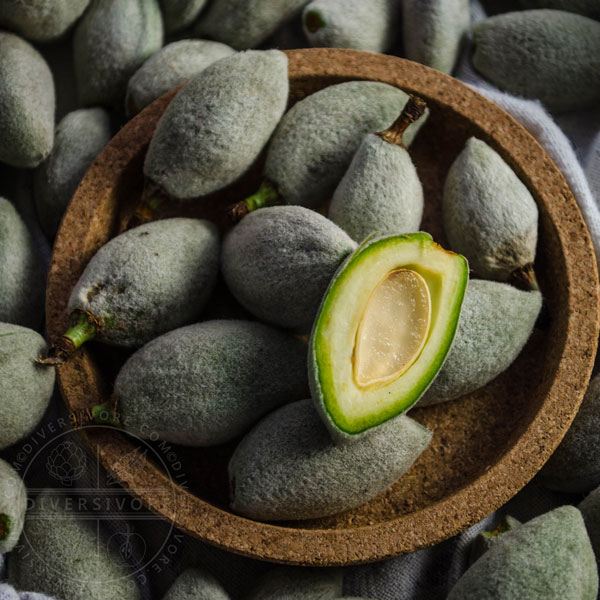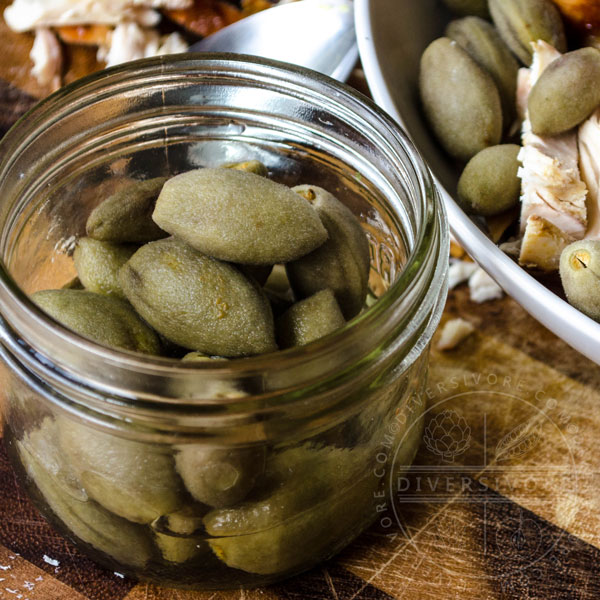How to Find, Choose, & Use
Green Almonds
Prunus dulcis

Share this Guide
The Basics
What Is It?
It's an almond... only younger! Green almonds are the immature fruits of the sweet almond tree, harvested while still soft, before the outer shell hardens and the inner kernel fully develops.
Seasonality
Available in EARLY SPRING, generally from April to early June in the Northern Hemisphere
Flavour Profile
Mild, slightly nutty and vegetal, moderately sour/acidic. The typical 'almond flavour' of older fruits is not particularly strong in green almonds.
Other Names
Farsi: Chaghal'eh badoom (badum/badam) - چغاله بادام
Green Almond FAQs
Are Green Almonds Poisonous?
Definitely not! The young fruit of the almond tree is edible in its entirety. While it is true that the bitter almond (sometimes called Prunus amygdalus) produces considerable quantities of cyanide in the mature seeds, these types of almonds are not harvested for use as green almonds.
Do Green Almonds Contain Cyanide?
All almonds produce some amount of cyanide through the hydrolysis of the compound amygdalin, but the amount found in sweet almonds (including green almonds) is extremely small and presents no danger to humans. Green almonds are likely to have even less amygdalin present, as the kernels have not yet developed fully.
How do you eat green almonds?
These small, mild, sour little fruits are most commonly served raw with sea salt, or pickled. Their brightness, crunchy textures, and pleasing acidity make them excellent additions to cheese plates, mezze, and charcuterie boards. They're also lovely (cooked or raw) in salads, pastas, and stews (e.g. the Persian favourite Khoresh Chagal'eh Badoom). The whole almond is edible, including the soft fuzz on the surface.
How-To
Find
Look for green almonds in the early spring at Persian (Iranian) grocery stores, Middle-Eastern and Mediterranean grocery stores, and well-stocked specialty markets.
Choose
Look for whole, unblemished almonds with soft, fuzzy exteriors. Avoid any green almonds with overly hard shells.
Prep
Difficulty: Easy - Green almonds only require gentle washing and the removal of any clinging stems before use. The stems can be gently snapped off using your fingers. The outer green layer can also be carefully cut away with a paring knife to expose the delicate inner kernels, if so desired.
Use
Often eaten raw or pickled, but equally nice when cooked as well. The delicate inner kernel is mild and sweet and can be used in desserts, salads, etc.
Store
Short Term: Refrigerate unwashed, up to 3 weeks (though shorter is better) in an open plastic bag in the crisper
Long Term: Lightly brine or pickle, then refrigerate or several months.
Culinary Info
Flavour Profile
Mild/Nutty/Sour/Green - Green almonds have a distinctive but mild and agreeable flavour. They don't have much of the distinctive almond flavour found in the mature nuts, and instead have a pleasantly acidic, somewhat vegetal quality.
Substitutions
There are no real substitutes for green almonds, though pickled or brined green almonds can substitute for fresh in cooked dishes.
Cuisines
Green almonds are particularly popular in Persian (Iranian) cuisine, but are also enjoyed in Mediterranean, North African, and Middle Eastern cuisines.
Flavour Pairings
Green almonds pair with a wide variety of flavours, but are particularly popular with salty cheeses, honey, roasted or stewed meats, and herbs like mint and dill.
Varieties
While there are different cultivars and varieties of sweet almond, distinctions are not generally made amongst green almonds, at least at a commercial level. Expect some variation in the size of individual fruits.
More Info
Nutrition
Note: this information is presented for GREEN (young) almonds, and differs from the nutritional information for ripe almonds. This information is somewhat limited by a relative lack of data. See Nutrition Note below for more information.
High in protein, and lower in fat than ripe (mature) almonds.Nutrition FactsGreen Almonds - 100 g (3.5 oz)Amount Per ServingCalories 337 Calories from Fat 225% Daily Value*Fat 25g38%Carbohydrates 15g5%Protein 14g28%* Percent Daily Values are based on a 2000 calorie diet.Top-To-Tail
The entire young green almond is eaten (including the soft shell) with the exclusion of the stiff and woody stem that may or may not come attached to the fruit. Mature almond kernels are, of course, commonly eaten.
GMO Status
There are no GM or gene-edited almonds in the human food supply.
Health & Science
- Very healthy, though it can be difficult to summarize some of the nutritional aspects
- Almonds have been associated with a risk of cyanide consumption in various media sources, however this risk is poorly represented and virtually zero in any commercially grown green almonds.
- Almond production has been associated with water conservation issues in California and other regions.Organic vs. Conventional
Green almonds are a fairly small/niche product, most green almond production is conventional. Individual farms and growers may be able to offer organic green almonds to consumers, but this is not (as of 2021) particularly common.
Share this Guide


